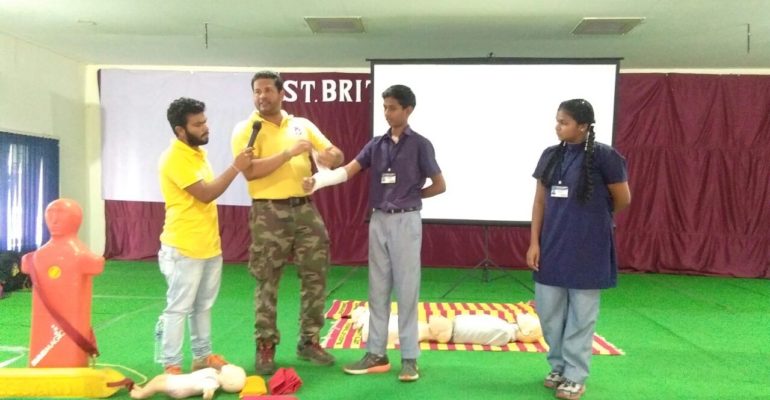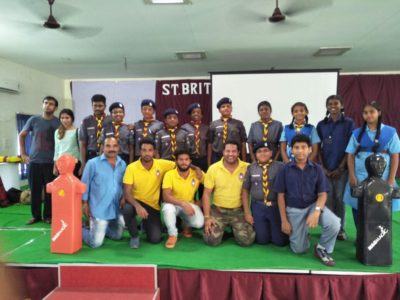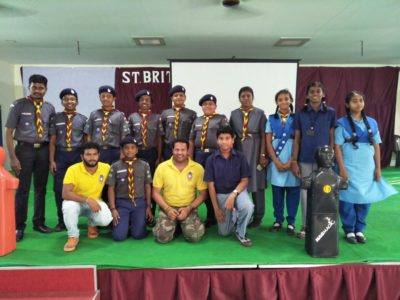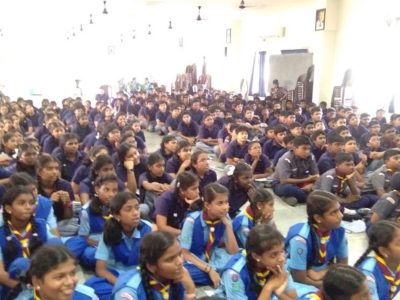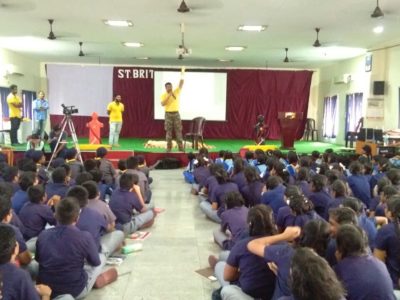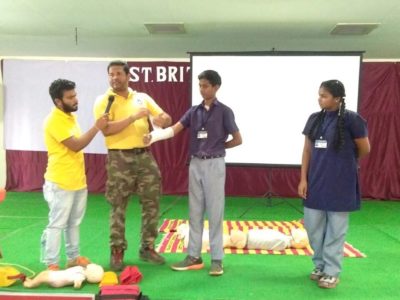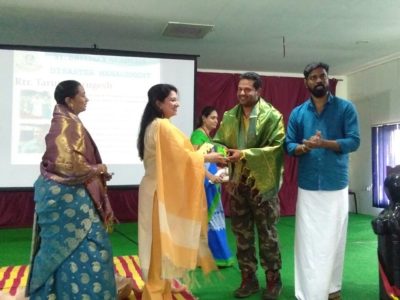A talk on disaster management was planned and proposed to be conducted by the Management of St. Britto’s Academy on 14.03.2018. As planned out, it was held on the scheduled day i.e. 14.03.2018.
Initially, the students were introduced to the topic of the day by a simple recapitulation on the concept of what are disasters and how to handle them with caution was briefed by the Mrs.Helena Gokul – Vice Prinicipal Mam, before the arrival of the Chief Guest.
INVOCATION:
The Session began with Tamil Thai Valthu. After that, a moment of silent prayer was invoked in remembrance of the trekking victims of Theni, Madurai District.
WELCOME SPEECH:
The Resource person – Mr.Tarun Murugesh was warmly welcomed and introduced to the gathering by a class 9th std – SBA student, highlighting his Academic skills, his Spectacular achievements in various arena, implausible social work and the laurels he had won till date in the field of being a Life-guard and a First Aid trainer.
WELCOME ADDRESS BY GUEST OF HONOUR:-
Our Beloved Correspondent Mam – Mrs.Vimala Britto gave an inspiring speech and aroused the eagerness and sowed the pulse to the session which was about to pursue then.
PRINCIPAL MAM – INTRODUCING THE GUEST:-
Respected Principal – Mrs. Mary James Mam welcomed the chief guest and handed over the stage to him.
CONTENT OF THE SESSION:
The Chief Guest Mr.Tarun initially started off with Brainstorming session with the students and started to probe them with mind blowing questions such as listed below.
- What is First Aid?
- Why First Aid is so vital?
- Who can offer the First Aid Service and for whom?
- What are the Emergency contact numbers an individual should be aware off?
- What is the appropriate time to call upon an Ambulance?
- What details to be kept ready and disclosed before dialling up an ambulance
- What is meant by the Golden Hour and the Platinum period for the victim to be rescued
MAIN CONTENT:
Mr. Tarun then quickly switched over to the five emergency situations in which First aid can be given by those who are proficiently and emotionally sound to that of the victim.
- Choking
- Bleeding
- Fractures
- Snake Bites
- Fainting and Electrical Shock
- Carrying the victims
FIRST AID EMERGENCY – HIGHLIGHTS:
There are basically 2 types of choking:
- Toddler / Infant Choking (Below the age of 1 year)
- Adult Choking
- CHOKING:-
- TODDLER / INFANT CHOKING
Items that enable infant choking:
- Infants can gobble up any item which they find on the surface of the floor while they crawl and play like; Coins, Marbles, Vegetables, Banana, Channa Dals, Plastics, Balloons etc.
- Breast feeding mothers – careless mistakes for instance, like sleeping and feeding and sitting on a stool and feeding etc.
Rescue Methodology:
- The Infant must be held with his head and body facing downwards and 5 slaps must be given at the back just few inches below his shoulder and above sternum in upward movement towards the neck without closing the mouth of the child.
Effects of Rescue Methodology:
- The above rescue operation will enable vomiting and this will help the choked particle to gush out at the same instance.
- ADULT CHOKING:
Rescue Methodology:
- Loosen his clothing’s at neck and towards his hips so as to keep the adult victim at ease.
- The Adults must be encouraged to cough more vibrantly with few minutes gap in between.
- Request the Adults to open his legs wide enough and then continue coughing.
- The Adult victim must be held from back and pressures must be given to the stomach area.
- Below his/her sternum, the rescue person must clench his fist and press his stomach area 5 times till he starts vomiting.
- Bend him / her against a chair which is placed just below his stomach area.
- Give him/her 5 back slaps just below the neck bone and in upward direction towards the neck.
Effects of Rescue Methodology:
- The above rescue operation will enable vomiting and this will help the choked particle to gush out at the same instance.
- BLEEDING:
- Generally, it happens due to bike accidents on traffic jammed roads/ highways or even at home, school, office wherein a person happens to carelessly handle or fails to notice sharp objects etc.
Rescue Methodology:
- Before treating the victim ensure whether your hands are clean and preferably wear gloves.
- Wash with tap cold water the bleeding area.
- Dip the cotton or any soft cotton cloth into diluted dettol / savlon and then place it over the bleeding area or on the wound.
- Fold that piece of cloth multiple times and place it on the wound and hold it and tie it up around his neck using a duppatta or any item…which would be more supportive and then raise it above the victims heart level
- For all this one must correctly identify the pressure points between the heart and the wound area.
- Pressure points are of 3 types:
- Direct pressure
- Elevated pressure
- Arterial pressure
- While tying the bandage, kindly ensure that you start from the bottom of the bleeding area and then rise up to the wound and go little further up and tie up the extra loop using a knot with your Index and middle finger so that the bandage has more grip.
Effects of Rescue Methodology:
- The above rescue operation will enable arresting/reducing the further flow/loss of blood.
III. FRACTURES:
They are of 2 types:
- Closed Fractures
- Open Fractures
How to identify that a bone is fractured?
- Excessive Swelling
- Immovability of ankle/toes
Rescue Methodology:
- Placing your Hand over his / her head is a psychological reassurance to the victim and helps him/her to maintain calmness and gain confidence.
- An external artificial support must be given at the first instance as the person will not be able to walk or move that affected part.
- Use a light weight bottom support material to the fractured area.
- Use Elastic / Pink Colour Roller Bandage as they can comfortably stretch out at our disposal.
- Wrap it around holding the affected part at right angle position starting to move from down to upward direction and tie up the extra loop using a knot with your Index and middle finger so that the bandage has more grip.
- Further tie it up around his neck using a duppatta or any shoe lace or scarf folded in triangular fashion which would be induce support and less painful to the victim.
- Don’t tighten up the bandage lest he will suffer movement.
Effects of Rescue Methodology:
- The above rescue operation will help the bone to be in shape before rushing the victim to the nearby Government hospital for further operation / treatment after diagnosis.
Note:
For open fractures the same methodology as enlisted above is adopted with a slight difference it is a circular shaped bandaging technique that is followed.
- HEAD INJURY
- Untoward incidents / major casualty on the roads/ highways can be cited as the reasons for such type of fatal injuries.
Rescue Methodology:
- Take a Cotton cloth or any Soft cloth and fold it multiple times.
- Keep it on the head of the victim whose top head skull is broken.
- Tie a Scarf around that cloth kept on the top of the head.
- Ensure that the scarf wound up around that cloth doesn’t cover up the victim’s eyes, ears and his jaws area.
- Tie up the extra loop of the scarf using a knot with your Index and middle finger at the back of his head i.e. near neck area so that it has more grip.
Effects of Rescue Methodology:
- The above rescue operation will help the victim in saving loss of blood before rushing the victim to the nearby Government hospital for further treatment.
- SNAKE BITES
- First must identify whether it is a poisonous / non-poisonous snake bite.
Rescue Methodology:
- Take any cloth and tie it not below or on the bitten area always.
- Tie it above the bitten area.
- Identify whether it is a poisonous / non-poisonous snake bite. This can be done by looking at the 2 holes in the bitten area. Triangular headed snakes are more venomous than round shaped headed snakes.
- If blood colour turns into bluish black then it is a poisonous snake bite, for certain.
- Always rush the patient to a Government Hospital.
- Don’t chase to hit the snake or kill it or burn it.
- While tying the cloth, kindly ensure that it is not tightened too much as it allows the poison to spread.
- Allow 2 finger gap space, while tying.
- Above all, don’t allow the victim to sleep and avoid all sorts of movement for the victim as poison can spread.
Effects of Rescue Methodology:
- The above rescue operation will help the victim to stay alive before rushing the victim to the nearby Government hospital for further treatment.
- FITS / FAINTING
- When there is electrical imbalance in the brain, FITS and Fainting occurs.
Rescue Methodology:
- Sprinkle water on kerchief and gently wipe the victim’s face with damp cloth.
- Avoid directly pour water on victim’s face.
- To help the victim and ensure he is regaining conscience, don’t tap hard on his cheeks or face. Gently tap on his shoulders. As it can give bad responses to the brain area.
- After the person regains consciousness, give some water with salt and sugar mixed in balanced proportions like 2 table spoons each.
- In the case of Fits, place a cloth between his tongue and teeth, instead of giving iron objects in the victim’s hand.
Effects of Rescue Methodology:
- The above rescue operation will help the victim to stay alive before rushing the victim to the nearby Government hospital for further treatment.
MISCELLANEOUS CONTENT:
Then Mr. Tarun taught the carrying techniques of the victim by calling upon SBA students to enact the scene. Many came forward to join in the show.
Then he spoke about DRABC Concept and the CPR methods were enacted using dummy models as how to blow in air pressing the nose of the victim lying him / her flat on the surface and then must give 30 compressions in the sternum area of the victim to regain the victim out of cardiac arrest.
FELICITATION:
One of the Rotary club members felicitated our beloved correspondent mam – Mrs. Vimala Britto with a shawl and then Mr. Tarun – The chief guest of the day was felicitated and gifted with a memento by our Respected Principal Mam – Mrs. Mary James who was in turn felicitated with a shawl by our Correspondent Mam.
CONCLUSION:
- The Students finally sang the National Anthem and dispersed at 4.15 p.m.
- Photo sessions were taken with the chief guest along with our scouts and guides team.
- The entire session was captured and recorded by the Asian College of Journalism – Team Members from Taramani – Mr. Shubham and Ms. Saanika.
- The Program was highly applauded and appreciated by the students and staff members.
- The chief guest spoke with full vigour and relentlessly too throughout the session showing his utmost dedication and commitment to his social work which captured the attention of the gathering.
- It ended off happily and it was highly informative as practical hands on experience were gained by the students and staff.

